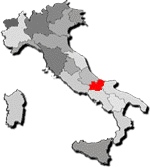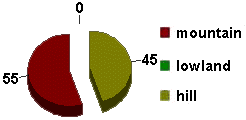 |
MOLISE |
 Back to Italy |
| Provinces
- This region has 2 provinces: Campobasso and Isernia Chief town - Campobasso Surface - kmq 4438 National Parks - National Park of Abruzzo (1923)  Russian Version |
 |
|
|
||
 |
MOLISE |
 Back to Italy |
| Provinces
- This region has 2 provinces: Campobasso and Isernia Chief town - Campobasso Surface - kmq 4438 National Parks - National Park of Abruzzo (1923)  Russian Version |
 |
|
|
||
 |
Origin of the Name |
| Reliefs - Passes - Coasts - Islands | |
| Landscape | |
| Agriculture - Stock-Farm - Fishing | |
| Industry - Tourism | |
| Position and Frontier | |
| Rivers - Lakes | |
| Climate | |
| Population | |
| Communication |
Origin of the name:
Historical fights in this region have left it's mark on
this land that can still be seen today. Historicaly Molise made
Abruzzi a part of the Roman region. Subsequently, this territory became the
land of Sanniti; conquered by Longobardis, Saracen, Byzantine, and later by
Fred II. The name Molise took hold, from the different feuds witch divided this
region. Later this region was demolished by an economic-social collapse that
continued also after the annexation to the Kingdom of Italy, where Molise
together with Abruzzi formed this region. In 1963 Molise it was divided from
Abruzzi and became independent.
Landscape:
The landscape is predominantly mountainous and hilly.
The soft mountains are rounded. The rocky ground is found in the
cultivated lowlands . Characteristic are the murettis around the farms as the
farmers removed the stones from the earth that they worked. The lawns where
they pasture sheep are very dry and rocky. Big cities are not found in the
Region. The small towns are found on the tops of the hilly promontories. The
coastal shore has no harbors and the zone it is not very populated.
Industry - Tourism:
Very important is the FIAT motor factory of Termoli and
the center of Agnone is famous for the production of bells. The more developed
sector is that of feed with conserved fittings, dairies and oil
crushers. The textile sector and wood have been present in this area
for a long time. Notable are the handicrafts and the production of the ends to
Tombolo and the manufacture of knives. Some small cities along the
coast are European's blu flags and there are three important archeological
sites: Altilia, Pietrabbondante e Larino.
Position and Frontier:
The extension of Molise goes from Appennino to
the adriatic coast, and it is included by river Trigno in the northern part and
river Fortone in the southern zone. It confines to north with Abruzzi and
Adriatic Sea, to east with Puglia, to south with Campania and to west with
Lazio and a small line of Abruzzo.
Rivers - Lakes:
The rivers are all of torrential character. The
principal of the adriatic slope are Fortone that flows in the zone however of
the region Puglia, Trigno and Biferno that goes down from Matese.
Climate:
The climate is continental typically with
winters colds and warm summers. The snowy precipitations abound in the
mountainous zones. The rains are scarce in the summer months. On the coast the
climate is mild.
Population:
The inhabitants of Molise prefer to live in the
countries and in the small suburbs. It is very rare to find single shed
residences in the territory. In the mountains and in the fertile hills we find
some desolate panoramas and abandoned places. Campobasso, the regional chief
town, in these last years is growning exceeding 50 thousand inhabitants.
Termoli and Isernia that which revolve around 20-30 thousand inhabitants are
the two greatest centers.
Communication:
The railway, road and motorway lines, assure the
communications with Abruzzi and Puglia along the adriatic coast. From Termoli a
secondary railway line departs that brings in Campobasso and continues for
Benevento. The streets of communication inside are very scarce, and hindered by
the mountains of the territory.
Web Site designed by MediaSoft - © Copyright 1998-1999 - All rights reserved